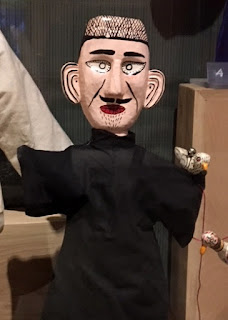 |
Topthorn from War Horse (built by
Handspring Puppet Company)
|
In recent years, I've fallen in love with puppet theater. Sometimes puppets have been the sole attraction, like Moses in Blind Summit's The Table at the 2014 Ringling International Arts Festival. (Click here to read about that show.) Other times they have taken the stage alongside human actors, like in freeFall Theatre's White Fang and its upcoming production of The Fantasticks. Seeing Topthorn from War Horse at the Center for Puppetry Arts made me seriously regret never having caught that show.
 |
| Pahlevan Mil Baz |
Puppet theater often utilizes stock characters that audiences immediately recognize. (Think commedia dell'arte characters like the doctor and the greedy old man.)
An Iranian example on exhibit was Pahlevan Mil Baz created by Mehdi Menati Moghadam in the early 1800s. He is a basic string puppet. The term pahlevan refers to an Iranian hero with athletic skills ranging from martial arts to strength training. Wrestling competitions featuring pahlevans date back to 651.
 |
| Pyongan Kamsa |
American puppet theater is in its infancy by comparison. While I'm sure the tradition dates further back, I learned that Pete Seeger got in on the act in 1939 when he created The Vagabond Puppeteers. The impetus for the creation of the group was unrest between New York State dairy farmers and milk distributors. Low prices were driving dairy farmers into bankruptcy. A dairy worker strike led to a 46% decrease of milk deliveries into New York City, and an ultimate increase in prices for dairy farmers.
 |
| Chesse's King Lear (string puppet, 1950s) |
While the strike was ongoing, Seeger, three compatriots and 22 puppets put more than 4,000 miles on an old Chevy traversing the state. Their shows included storytelling and folk songs and both raised the spirits of striking farmers and educated the general public about the issue.
None of Seeger's puppets were on display at the Center, but there was a great King Lear (circa 1950s) created by Ralph Chesse. Chesse was an actor and painter who became a puppeteer as a way of putting all his skills to use. The development of puppet shows was the ultimate in creative autonomy, as Chesse did everything from designing the sets to building the puppets to acting all the parts.
His first show was an adaptation of Shakespeare's Hamlet in 1928. In later years, Chesse headed up the Federal Theater's Marionette Project for the WPA. For some pictures of Chesse's productions, click here.
 |
Male with Sunglasses from
Modern Revolutionary Opera
(Chinese shadow puppet, date unknown)
|
The Center employs two full-time people responsible for building puppets from materials like foam and masking tape. The holiday production of Rudolf the Red -Nosed Reindeer will include 69 puppets and six actors. In addition to the Center's lone full-time puppeteer, the cast will be drawn from Atlanta's acting community. No puppeteering experience is required, but the actors have to be able to sing and dance and be physically fit. (The last requirement comes in because the puppeteers have to do all the work stagehands would do in a more traditional theater production.)
But the Center doesn't only produce family-friendly shows. Its season also includes The Ghastly Dreadfuls, a Halloween-appropriate show featuring stories, songs and dances from around the world, and a full-length production of Ashes, an adaptation of a Norwegian novel about a community suffering from a rash of house fires. A quick trip to Atlanta might be in order.
For more information about the Center for Puppetry Arts, click here.



No comments:
Post a Comment